Fast, Ultra-fast and High-resolution LC for Separation of Small Molecules, Oligomers and Polymers
LCGC Europe
Matthias Pursch,1 Andreas Schweizer-Theobaldt,1 Hernan Cortes,2 Angelika Gratzfeld-Huesgen,3 Helmut Schulenberg-Schell3 and Bernd-Walter Hoffmann,3 1Dow Deutschland Anlagengesellschaft mbH, Analytical Sciences, Rheinmünster, Germany, 2The Dow Chemical Company, Analytical Sciences, Midland, USA, 3Agilent Technologies Deutschland GmbH, Waldbronn, Germany.
High-speed liquid chromatography is becoming important in many pharmaceutical and biochemical laboratories because of the demand to analyse complex samples quickly.1 The availability of small-particle columns (less than 2 µm particle size) has paved the way for LC separations with short analysis times, while maintaining — or even increasing — high separation efficiencies.

There is a growing interest in this new generation of LC columns for a wide range of chemical applications, including small molecules, oligomers and polymers. The availability of high pressure liquid chromatography (HPLC) systems that operate at high pressures (> 400 bar) allows the use of long, small particle columns. Such columns are now available at lengths up to 150 mm. Thus, high resolution LC separations can be generated for difficult separations of complex mixtures. Recent experimental studies revealed that sub-2 µm particle columns show superior kinetic performance (peak capacity) compared with 3–3.5 µm particles, when operated at high-pressures and run times of less than 30 min.2
Fast LC columns of different lengths were evaluated in terms of column performance. It should be noted that some of these were prototype/experimental columns. Some columns were coupled to assess the maximum possible plate numbers for high-efficiency separations. Experiments were performed with the 1200 Series Rapid Resolution LC system (Agilent Technologies, Waldbronn, Germany), which operates at pressures up to 600 bar. A fast scanning diode array detector (DAD) with a maximum scan rate of 80 Hz was used.
Higher temperatures were recently applied to obtain high performance liquid phase separations with sets of coupled conventional columns.3,4 This concept was also applied to our investigations which include the separation of epoxy resins. Examples of fast LC for the determination of copolymer composition and functionality type distributions are described. Finally, ultra-fast separations of inhibitors were used to assess system performance.
Figure 1 illustrates a typical high-resolution separation of SRM 869a (National Institute of Standards and Technology (NIST), Gaithersburg, Maryland, USA) — a shape selectivity and column test mixture,5 which is available from the National Institute of Standards and Technology (NIST). For this example, two small-particle columns were coupled for a total length of 150 mm. Excellent column efficiency was observed with plate numbers of N = 37000 for tetrabenzonaphthalene (TBN) or about 250000 plates/m. Figure 2 shows the performance of several individual and coupled columns. All columns were of 4.6 mm internal diameter (i.d.) with a 1.8 µm Zorbax SB-C18 silica (Agilent Technologies, Wilmington, Delaware, USA) as the packing material and some of these were prototypes.
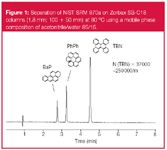
Figure 1
Theoretical and experimental plate numbers were evaluated for TBN at 80 °C and flow-rates near the optimum of the Van Deemter curve (1.5 mL/min). The efficiencies of these experimental columns varied. For example, the coupled 100 and 50 mm columns showed higher N values than a single 150 mm column. This was possibly because the shorter columns were packed more homogeneously or the prototype/research character of some of the longer columns. In general, it is more difficult to pack long columns with sub-2 µm particles. It is apparent that some efficiency was lost in column connections when constructing the very long columns. However, the availability of 50000–70000 plates for a given separation (400 mm total column length) may be very beneficial for highly complex mixtures, where high peak capacity is preferred over column selectivity and short analysis times.
From a practical perspective it needs to be ensured that all fittings and connections from injector to detector (including column connections) are mounted carefully to allow for the lowest additional dead volume or extra-column band broadening. The influence of additional dead-volume will be more pronounced when going to smaller i.d. columns such as 3.0 mm or 2.1 mm i.d. The appropriate capillary connections are also important and should be below 150 µm i.d. to reduce extra-column band broadening. A thorough description of peak dispersion effects, including system dwell volume, can be found elsewhere.6 With an optimized set-up (125 µm i.d. capillaries, 2 µL flow cell, 80 µL solvent mixer) an extra-column band broadening of only 15 µL was determined using the procedure of Lauer and Rozing.7 This measurement did not include any additional dead-volume present in column-to-column connections.
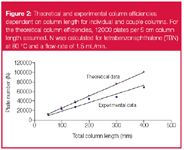
Figure 2
Several Zorbax Rapid Resolution (Agilent Technologies, USA) columns for high-resolution LC were used to separate complex samples. Epoxy resins are composed of various oligomers and different substitution patterns (Figure 3). They are therefore an ideal class of compounds for when high peak capacity is needed. An extended temperature range of the LC system with solvent-pre-heating and post-column cooling enables the use of longer columns without deteriorating the UV baseline performance. Total column lengths of 150 mm and 400 mm were used for this application. A temperature of 80 °C was sufficient to generate a backpressure of 552 bar with the 400 mm columns at about 40% water in acetonitrile. As can be seen from Figure 3 the peak resolution is excellent. It can be noticed though, that components that elute later are not fully resolved because of the presence of multiple isomeric constituents.

Figure 3
The first three isomer peaks are fully baseline separated. Even minor peaks are observed inbetween the main isomers. For the p,p' peak of the n = 1 oligomer a shoulder is observed which indicates the presence of additional isomers. Such a separation has not been achieved before, and a total run time of about 12 min is still acceptable considering the wealth of information that is accessible. Separation is further improved because for the p,p' peak (n = 1) the isomer separation is more obvious in the lower chromatogram using the longer set of columns.
Operation at high temperatures has advantages and limitations. The benefits are reduced viscosity of the mobile phase, which allows higher flow-rates to be applied, which reduces analysis times. Reduced viscosity is valuable, particularly for mobile phase gradients with a high percentage of water (> 50%) at starting conditions. However, a temperature increase shifts the minimum of the Van Deemter curve to higher linear flow-rates. Therefore to operate at optimal conditions the flow-rate must be increased.
Temperature also has an effect on stationary phase selectivity and can be used to tailor a separation for optimal peak resolution.8 This means high-temperature LC can be beneficial or disadvantageous, depending on the components to be separated. Preheating of the mobile phase is required; otherwise peaks may broaden as a result of thermal mismatch. A possible drawback is the limited stability of silica-based packing materials at high temperatures (> 80 °C), however, it should be noted that manufacturers are investigating ways to increase stability in this regard.
Polymer analysis by LC can be executed in three different modes: size-exclusion chromatography (SEC), LC at the critical point of adsorption [the liquid chromatography at critical conditions (LCCC)] and gradient LC (adsorption or precipitation– redissolution).9 The first methodology is governed by entropy (separation by hydrodynamic volume), adsorption LC is driven by enthalpic effects. LCCC is driven by a balance of enthalpic and entropic effects. Gradient LC of polymers enables separations according to differences in chemical composition distribution (CCD). For copolymer analysis this is a powerful tool to measure polymer composition and assess the distribution of the composition.
A series of styrene-co-acrylonitrile (SAN) copolymers was analysed by fast gradient LC using a 50 mm C18 column (Agilent Technologies, USA). Mobile phase gradient was run from acetonitrile towards dichloromethane. With acetonitrile as the initial mobile phase, high styrene-containing polymers precipitate on the column and will be redissolved with the stronger solvent.
In Figure 4 high-speed polymer separations are displayed. A correlation of retention time with polymer composition (in terms of %-acrylonitrile content) is also shown in Figure 4. An excellent linear relationship is observed and cycle times are 4–5 min, which illustrates the method is suitable to rapidly assess the chemical composition of copolymers.
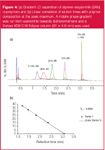
Figure 4
Critical LC is an important tool for polymer analysis because it separates molecules, independent of their molecular weight, according to differences in end groups.10, 11 Ultra-high speed critical LC (LCCC) was attempted using a 1.8 µm silica column (100 mm × 4.6 mm). Epoxy resins, which contain a variety of functional end groups, such as phenolic, epoxy, glycol and others, were used as an example for this separation methodology.11 The corresponding separations, along with some structural assignments, are displayed in Figure 5. The mobile phase consists of 1–5% methanol in dichloromethane. The overall solvent viscosity is therefore very low, which allows high-speed analysis even at normal pressures. Separation efficiency is excellent and up to twelve different functionalities can be assigned. (Figure 5). Analysis time is less than one min so ultra-fast LCCC could also be used in the second dimension in comprehensive 2D LC applications for polymer or oligomer analysis.
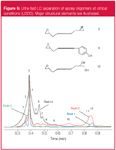
Figure 5
Inhibitors are important compounds added to increase the long-term stability of polymers. Five inhibitors (four of which were phenolic) were selected for ultra-fast LC analysis. A conventional method uses an aqueous buffer–acetonitrile mobile phase gradient with run times of about 20 min (including reequilibration). It should be emphasized that the conventional method ran at ambient temperature and normal flow-rates and thus was not fully optimized. Using a 50 mm high-speed LC column the separation of a synthetic mixture of five inhibitors is achieved in less than 1 min and the total run time was under 2 min. (Figure 6).
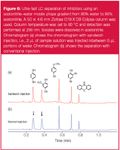
Figure 6
This is about ten times faster than the conventional method. It is obvious that the first two peaks in the bottom chromatogram are very broad. One reason for this broadening is that the solutes are dissolved in a much stronger solvent (acetonitrile) than the starting mobile phase (10% acetonitrile in water). Using an injector programme, which draws specified amounts of water before and after the sample solution (so-called "sandwich injection"), the first two peaks could be sharpened significantly as shown in the top chromatogram. It should also be noted that at the very short elution times (< 0.35 min), the effect of the mobile phase gradient has not fully reached the column under the applied instrument conditions.
Column and system stability during high-pressure and fast gradient operation is another requirement for successful implementation of high-speed and high-resolution LC. Figure 7(a) shows two series of twenty injections during isocratic runs with pressures of 490 bar. Relative standard deviations (RSDs) of 0.37% and 0.27% were determined for the retention times. After the first injection the retention times increased very slightly until a plateau was reached. It is not currently understood if this is caused by incomplete thermal equilibration of the column or other reasons. Thermal equilibration would certainly require more time for the small particle columns as a result of stronger heat generation by friction.12
The multiple-injection experiments were started after 15 min of pump operation. Thus it appears that full equilibration takes more than one hour. Still, the measured retention time RSDs are very small and fully acceptable for all compounds, including the first injections. For ultra-fast gradient analysis in Figure 7(b), the small increase in retention times with the number of injections was not observed. The gradient method showed excellent retention time reproducibility — an RSD of 0.1% was measured for phenothiazin. Both experiments show the ruggedness of the system under challenging operating conditions.

Figure 7
In addition, during our evaluation, which included the analysis of various epoxy resins and copolymers, no significant column pressure build-up was observed. It should be noted that bacteria growth in water or aqueous buffers can lead to column plugging. Appropriate measures, such as preparation of fresh eluents, addition of small portions of organic solvents to water/buffers, are required to combat this. Experiences gained during method transfer from 5 to 3–3.5 µm column packings are also certainly valid when using sub-2 µm column technology. Additional measures to consider for fast LC include the adjustment of the detector sampling rate. Typically 10–20 Hz are sufficient, unless separations are performed in less than 1 min. In such cases 50 Hz or more will be required for optimal peak resolution. A detailed summary of the most important adjustments for fast and ultra-fast LC has been described by R. Majors.1
Conclusions
Fast, ultra-fast and high resolution LC technology has great potential for R&D method development, quality control and high-throughput analysis in chemical industrial applications. Depending on the complexity of the separations, analysis times can be reduced by a factor of five to ten without sacrificing resolution. Short, small particle columns have great potential for comprehensive 2D LC, where a fast 2nd dimension separation is needed. The application of high temperature allows longer small particle columns to be used, without dramatically increased the separation time. High-resolution LC with long or coupled columns is ideally suited for complex mixtures, such as oligomers, where previous separations have not been satisfactory.
Improved separation performance could be achieved by further optimization of packing materials, such as the application of partially porous silica,13 by further reduction of the particle sizes and particle size distribution, and by optimization of the column packing processes. Comprehensive 2D LC (LC × LC) will become more popular because it achieves much higher peak capacity and selectivity than high-resolution LC in one dimension — even although there are some inherent limitations because both dimensions are not usually operated at optimum conditions. Finally, fast polymer LC analysis is also improved by using sub-2 µm columns. The range of applications for fast and high-resolution LC will increase with innovative stationary phase chemistries and columns types.
Acknowledgment
We thank Mary Cuddyre, Gabriele Anders and Matthias Schierhorn (Agilent Technologies) for excellent support. We also thank Gisela Jeschek (Dow Deutschland) for experimental support. Lane C. Sander (NIST, Gaithersburg, MD, USA) is acknowledged for donation of SRM869a samples.
References
1. R. Majors, LCGC Europe, 19, 352–362 (2006).
2. D. Cabooter et al., J. Chromatogr. A., 1147, 183–191 (2007).
3. F. Lestremau et al., J. Chromatogr. A. 1109, 191–196 (2006).
4. F. David et al., LCGC Europe, 20, 154–158 (2007).
5. L.C. Sander and S. A. Wise, LCGC International8, 378–390 (1990)
6. R.E. Majors, LCGC Nr. Am., 21, 1124–1133 (2003).
7. H. H. Lauer and G. P. Rozing, Chromatographia, 14, 641–647 (1981).
8. L.C. Sander and S.A. Wise, J. Sep. Sci., 24, 910–920 (1981).
9. H. Pasch and B. Trathnigg (Ed.), HPLC of Polymers (Springer, Berlin, Germany, 1998).
10 A. A. Gorshkov et al., J. Chromatogr., 523, 91–102 (1990).
11 A.V. Gorshkov et al., Chromatographia, 26, 338–344 (1988).
12 A. De Villiers et al., J. Chromatogr. A, 1113, 84–91 (2006).
13 J.J. Kirkland, T. Langlois and J.J. De Stefano, Am. Laboratory, 39, 18–21 (2007).
Matthias Pursch is global LC technology leader at The Dow Chemical Company. His current research interests include development and identification of new technology to advance liquid phase separations for a wide range of chemical applications.
Andreas Schweizer-Theobaldt is analytical specialist at The Dow Chemical Company. His research interests include oligomer and polymer characterization using liquid chromatographic techniques.
Hernan Cortes is leader of the global Analytical Sciences Separations Discipline at The Dow Chemical Company. He is author/co-author of a large number of external publications and is a well-known speaker at international chromatography conferences. His research interests include the advancement of liquid and gas phase separation technologies, among them high-speed and multi-dimensional chromatography.
Helmut Schulenberg-Schell is worldwide marketing manager for LC systems and modules at Agilent Technologies. His research is devoted to sample preparation and microfluidics.
Angelika Gratzfeld-Huesgen is application chemist at Agilent Technologies. Her current research interest includes sub-2 micron particle columns and its consequences and effects on design of LC instrumentation.
Bernd-Walter Hoffmann is senior R&D Chemist at Agilent Technologies. His current research interest includes separation sciences with a main focus on high performance HPLC systems and associated column development.

Polysorbate Quantification and Degradation Analysis via LC and Charged Aerosol Detection
April 9th 2025Scientists from ThermoFisher Scientific published a review article in the Journal of Chromatography A that provided an overview of HPLC analysis using charged aerosol detection can help with polysorbate quantification.
Removing Double-Stranded RNA Impurities Using Chromatography
April 8th 2025Researchers from Agency for Science, Technology and Research in Singapore recently published a review article exploring how chromatography can be used to remove double-stranded RNA impurities during mRNA therapeutics production.













